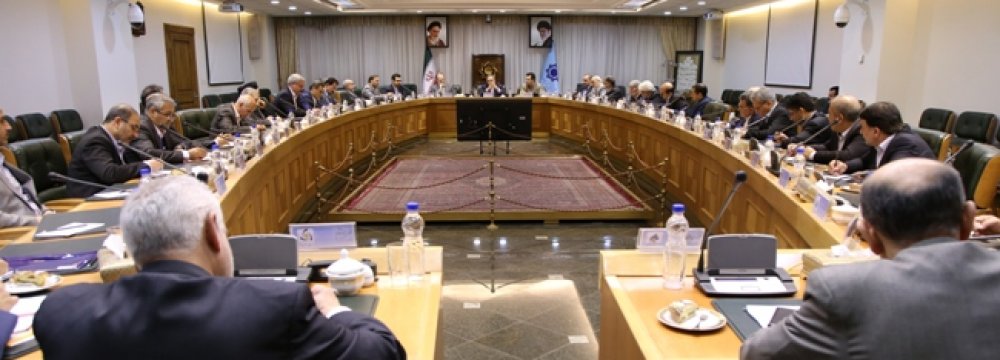
CBI Underscores Microfinance

“As it is common all over the world, banks’ responsibility is to finance micro, small- and medium-sized enterprises whereas macro enterprises acquire their funds from the capital market, but in our country the situation is such that the banking system has to shoulder 90% of the country’s entire finance,” Seif was also quoted as saying by CBI’s official website.
The Iranian economy has for long been a bank-based one but in recent years and with the situation of Iranian lenders deteriorating, officials have begun to awake to the importance of the burgeoning capital market and its role in financing big projects.
Seif noted that banks have recently started to issue credit cards ranging from 50 million rials ($1,188) to 500 million rials ($118,850) and expressed hope that in the wake of such measures, all groups of people will be able to use banks’ resources.
“Experiences show that by financing MSMEs, banks' resources will be headed to where they should go and as the society is in need of these kinds of loans, banks can be sure that their loans will not turn into non-performing ones,” he added.
According to the World Bank, access to financial services can boost job creation, raise income, reduce vulnerability and increase investments in human capital.
MSMEs account for a significant share of employment and GDP across the world, but when they have limited access to finance, the economy suffers a series of negative consequences: Economic and social opportunities are restricted, enterprise creation and growth are restrained, households and enterprises are more vulnerable to threats, and payments are costlier and less safe.
Seif noted that the plan to support small- and medium-sized enterprises is a necessity for Iran’s economy and in line with that, the banking system has considered a total of 200 trillion rials ($4.75 billion) to provide for various sectors’ working capital, 100 trillion rials ($2.37 billion) for renovation of production lines and another 200 trillion rials ($4.75 billion) for employment.
“As the plan is very effective and essential for the country’s economy, I ask banks to follow up the issue until all of the considered resources have been allocated to the applicants,” he said.
Rate Cuts Hailed
The CBI governor emphasized that a group of people are trying to sabotage the banking system’s achievements by claiming that banks do not observe the lowered interest rates and regarded measures for rate cuts as constructive.
“Reducing the interest rate on deposits has significantly reduced the costs of banks’ resources, which helped them to make up for their income-expense gap and this is while the whole country’s economy will benefit from its results, as banks will be able to allocate loans at lower interest rates,” he added.
As per the directive in August, banks and credit institutions were obligated to refrain from paying high interests–that went up to 23%–after Sept. 2, and cap their interests on one-year deposits at the previously set 15% while paying a maximum interest of 10% to short-term deposits.
Seif referred to the imbalance between banks’ incomes and expenses, assets and liabilities and also liquidity issues as the three major problems of the country’s banking system.
“Banks need to be injected with new resources to deal with their asset-liability issue and as for their income-expense imbalance, banks need to seriously consider a way to cut their operational and non-operational expenses," he said.


Trump weighs using $2 billion in CHIPS Act funding for critical minerals

Codelco cuts 2025 copper forecast after El Teniente mine collapse

Electra converts debt, launches $30M raise to jumpstart stalled cobalt refinery

Barrick’s Reko Diq in line for $410M ADB backing

Abcourt readies Sleeping Giant mill to pour first gold since 2014

Nevada army depot to serve as base for first US strategic minerals stockpile

SQM boosts lithium supply plans as prices flick higher

Viridis unveils 200Mt initial reserve for Brazil rare earth project

Tailings could meet much of US critical mineral demand – study

Kyrgyzstan kicks off underground gold mining at Kumtor

Kyrgyzstan kicks off underground gold mining at Kumtor

KoBold Metals granted lithium exploration rights in Congo

Freeport Indonesia to wrap up Gresik plant repairs by early September

Energy Fuels soars on Vulcan Elements partnership

Northern Dynasty sticks to proposal in battle to lift Pebble mine veto

Giustra-backed mining firm teams up with informal miners in Colombia

Critical Metals signs agreement to supply rare earth to US government-funded facility

China extends rare earth controls to imported material

Galan Lithium proceeds with $13M financing for Argentina project

Kyrgyzstan kicks off underground gold mining at Kumtor

Freeport Indonesia to wrap up Gresik plant repairs by early September

Energy Fuels soars on Vulcan Elements partnership

Northern Dynasty sticks to proposal in battle to lift Pebble mine veto

Giustra-backed mining firm teams up with informal miners in Colombia

Critical Metals signs agreement to supply rare earth to US government-funded facility

China extends rare earth controls to imported material

Galan Lithium proceeds with $13M financing for Argentina project

Silver price touches $39 as market weighs rate cut outlook

















